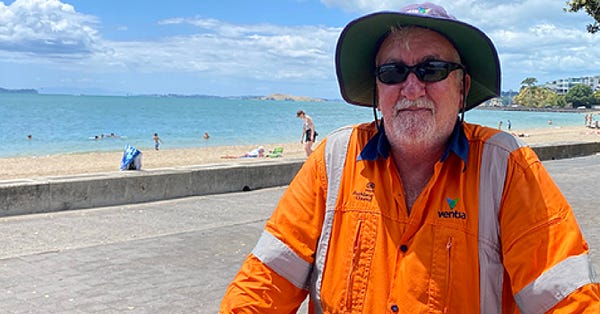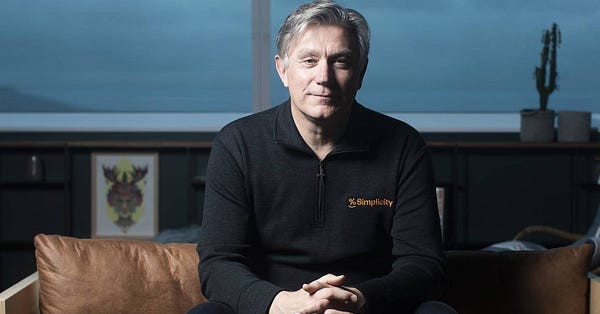⏩Fast Forward Aotearoa #31: turning research outputs into mission outcomes🧐bivalent💉bus-trams for Ōtautahi?🚈3D printed buildings are here🏢smart bins are here🚮
Then a miracle occurs
Kia ora,
Welcome to this week’s ⏩Fast Forward Aotearoa from Memia, my usual sift of thinking about the future of Aotearoa New Zealand.
In today’s issue:
💉Bivalent vaccines are arriving on 1st April, don’t expect major differences in protection
🚈Bus-trams Looking at new plans for a rapid transit corridor for Ōtautahi
The first 🏢3D printed building in the southern hemisphere is a childcare centre in Kirikiriroa
🚮Smart bins a straightforward IoT case study delivers efficiency, productivity and emissions benefits
🤑Excess profits? the four biggest Australian-owned banks returned over NZ$6Bn of after-tax profits last year… seriously time for a ComCom enquiry?
🏔️Where to from here? How we ensure the future wellbeing of land and people a look at MfE’s recent long term insights briefing
🫣What are you personally optimistic about? responding to Rowan Simpson’s latest post
Then a miracle occurs: ⏩Fast Forward Aotearoa #31, Turning research outputs into mission outcomes🧐
Thanks for reading!
Memia Webinar: Hive Mind with Sam Ragnarsson, Human + AI productivity tools
This Friday 4pm NZT an invitation to Memia to join myself and ever-energetic innovator Sam Ragnarsson for an informal webinar to compare notes on the Human+AI tools we’re both using these days and some tips and tricks we use to improve our personal productivity. Register here
(Event for paid subscribers only)
We had a bit of fun putting this together using DALL-E 2…1
Aotearoa roundup
Stories from around the motu catching my eye in the last couple of weeks. (Not an AI in sight…!)
💉Bivalent
Back in October I asked Bivalent When? (Memia 2022.40) after Australia had started rolling out the new bivalent (eg two combatting two strains) vaccine. Nearly 5 months later, answer: April 1st for over-30s and others:
(Book from late March through the bookmyvaccine website, on 0800 28 29 26, or through your primary care provider).
Science Media Centre asked four academic experts from Auckland, Canterbury and Otago Universities to comment: Omicron-specific vaccine approved for over-30s – Expert Reaction:
“Procurement of a bivalent Covid-19 vaccine is a logical move at this stage of the pandemic but these vaccines are not game-changers.
“The bivalent Covid-19 vaccine includes the original variant that first appeared in Wuhan (the ancestral strain), as well as a more recent variant related to the Omicron family. The idea is that it will provide superior protection over the original monovalent (single) vaccine that most people have already received by presenting additional SARS-CoV-2 diversity to the immune system.
“The bivalent booster vaccination does appear to have an edge over the single-valent version, but not an awful lot. It has shown benefit in reducing infections and hospitalisations, and has greatest impact in those at increased risk, including elderly people and those with a medical risk condition.“
— Associate Professor Helen Petousis-Harris, Vaccinologist, University of Auckland
In the US, the New England Journal of Medicine included a perspective piece in January: Bivalent Covid-19 Vaccines — A Cautionary Tale questioning whether bivalent vaccines should be applied broad-spectrum across the whole population or just targeted at those at higher risk of severe infection. (Which possibly contributes some way towards the over-30s policy positioning here…)
🚈Bus-trams for Ōtautahi?
Plans for a new rapid transit corridor for Ōtautahi were unveiled by the Greater Christchurch Partnership (a “voluntary coalition of local government, mana whenua and government agencies working collaboratively”).
The plans are a long way from being realised… but are likely to cost far less proportionally than the ever-more-unlikely NZ$14Bn (and counting) Auckland Light Rail project.
Stuff discusses the main choices in some depth: Should Christchurch have rapid buses or light rail? To be honest, the technological timing is just perfect now for battery-powered electric “bus-trams” which run on tyres and don’t need overhead power lines as are currently being rolled out as part of the Brisbane Metro:
🏢3D printed buildings are here
Flagged exactly a year ago in Memia 2022.08, Qorox is a Tāmaki Makaurau startup focused on 3D printed concrete solutions. They are now helping to build the first 3D concrete printed commercial building in the Southern hemisphere, a new childcare centre in Kirikiriroa:


🚮Smart bins are here
IoT case study from Datacom: in a joint trial, Ventia implemented sensors on Wellington bins and connected to Datacom’s Timpani IoT platform to optimise rubbish collection. Early claimed results (“up to” and “could” are vague words…):
“Driving time on each route could be reduced from up to 7.5 hours to four hours.
This reduction also gave Ventia the ability to reduce its fleet by up to eight vehicles.
Carbon emissions were also reduced; applying the process to the 30 routes Ventia services across Auckland could reduce CO2 emissions by 51 metric tons annually.”
With chronic labour shortages and high fuel / vehicle costs the “new normal”, these kinds of IoT solutions are now relatively affordable and simple to deliver significant efficiencies. Watching out for more.
🪟Big picture
Two longer reads:
Simplicity’s Sam Stubbs calling for a Commercce Commission enquiry after the four biggest Australian-owned banks returned over NZ$6Bn of after-tax profits:
“That’s over $16 million a day, $680,000 an hour, $11,000 a minute, $180 a second.“
I find myself nodding along in agreement… the whole fractional reserve banking system still feels like a conjuring trick (eg Reserve Bank magics imaginary money out of nowhere and then allows a handful of commercial banks to on-lend at high margins and near-zero risk) remains in place in 2023 when there are surely better technologies to facilitate peer-to-peer transactions and lending amongst ourselves.
🏔️The Ministry for the Environment released its Long Term Insights Briefing for 2023: He aha ngā mahi ka whai ake ināianei? Me pēhea te whakarite i te toiora o te whenua me te tangata ā muri atu | Where to from here? How we ensure the future wellbeing of land and people.
The challenges to the natural environment have never been larger:
Heavy going in places but worth reading, the report identifies a “3 horizons” type approach to getting back on track:
Tracing back from an aspirational future to the present situation – a futures-analysis technique known as backcasting – identifies nine pathways we could use to influence change. These are structured across three tiers, with three specific leverage points in each.
Achieving incremental change – leverage points that are effective at increasing resilience and addressing specific events, but which have less effect on overall systemic pressures:
increasing effectiveness of policy and legislation
investing in sustainable infrastructure and technology
empowering communities.
Supporting transitional change – leverage points that go deeper into the origins of the problems and help transition systems and institutions for more widespread change:
investing in environmental education and knowledge transfer
investing in science and mātauranga Māori
embracing collaborative governance and coordination.
Enabling transformational change – leverage points that address the root causes of environmental issues. While more complex and challenging to implement, they have greater ability to bring about long-lasting change:
embedding environmental responsibility into Aotearoa New Zealand’s institutions
enhancing equity
building resilience to global pressures.
Rollcall
Before we get into it, one shout out this week:
😰Anticipate, 🔀 Align, 🦾 Automate
Rowan Simpson wrote his first Top Three blog post in a while, recalling this rather dark note by Brian Eno from 2009:
“THE FEELING THAT THINGS ARE INEVITABLY GOING TO GET WORSE
[It] is not even a thought. It’s more of a feeling.
Human development thus far has been fuelled and guided by the feeling that things could be, and are probably going to be, better.
…
What if this feeling changes? What if it comes to feel like there isn’t a long term—or not one to look forward to? What if, instead of feeling that we are standing at the edge of a wild new continent full of promise and hazard, we start to feel that we’re on an overcrowded lifeboat in hostile waters, fighting to stay on board, prepared to kill for the last scraps of food and water?
…
What happens then?
Rowan’s counterchallenge for an uncertain 2023:
“I first referenced that piece in 2009, around the time that Barack Obama was inaugurated. As I said then, it was a bit of a “counterbalance to the general feeling of hope and optimism”.
Now it seems the exact opposite is required.
So the questions I have for you are:
What are you personally optimistic about?
What are you looking forward to? (“Getting back to normal” isn’t an accepted answer: back != forward).
What do you believe is going to be better in the future than it is right now?
What are you doing to contribute to that?
And, if you can’t think of anything significant, then what are the consequences of that?“
Rousing. But when I look out towards the horizon I now see so many different possible scenarios that I find it hard to “believe” anything with any conviction even just a few months out. The interplay of so many variables is now soooo complex and I don’t do “Faith”. Pick from:
“The world will get worse”: climate change doom, biodiversity collapse, unaligned superintelligent AI, escalating conventional wars, nuclear conflict, growing intergenerational economic inequality, pandemics, housing shortages, asteroid impacts…
“The world will get better”: DACCS and geoengineering, nature regeneration, increasing life expectancy and healthspans, broadband satellite internet, large language models, decarbonisation of the economy, (/except:) rockets aiming for the Moon again, 3D printed abundance, 4-day working weeks, anti-aging lifestyles, human+AI augmentation…
🫣Bill Hicks nailed it 30 years ago (NSFW), nothing’s changed!
⏩Fast Forward Aotearoa #31: Turning research outputs into mission outcomes🧐
In last week’s ⏩Ffwd post I left off by posing the following three questions:
How should Aotearoa determine its “mission led” research and innovation priorities?
How does “mission led” research become a “mission led” solution?
How does technology investment fit into it all?
Paid subscribers read on below…
Keep reading with a 7-day free trial
Subscribe to Memia to keep reading this post and get 7 days of free access to the full post archives.









